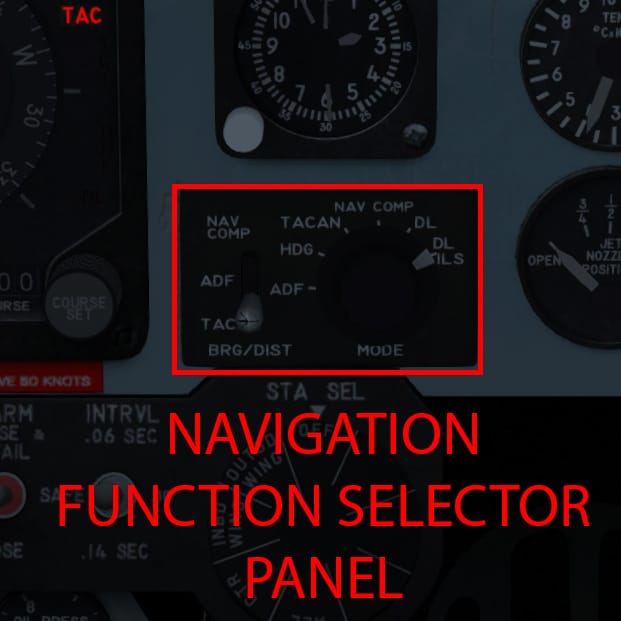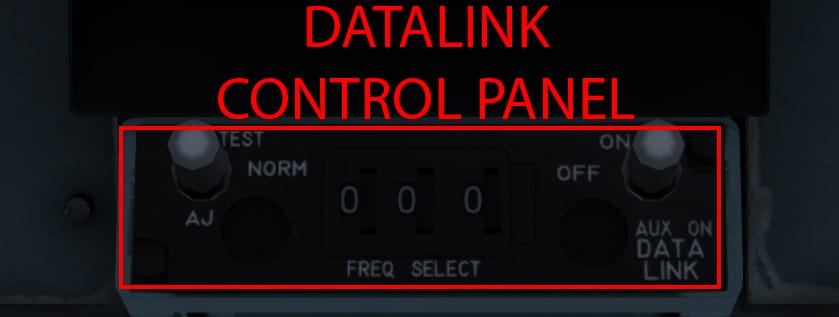Automatic Carrier Landing System #
The Automatic Carrier Landing System (ACLS) is fully simulated in the SWS F-4 Phantom based on real-life data. The ACLS can connect to any CEX-enabled carrier, allowing a hands-off approach to the carrier.
During an automatic approach, attitude information is sent from the aircraft to the carrier, while the carrier’s ICLS system keeps track of the aircraft’s position on approach. Corrective control signals are sent from the ship to the aircraft’s automatic flight control system, which moves the control surfaces and keep the aircraft on the correct lineup and glide path.
The ACLS system, coupled with the F-4 Phantom’s Approach Power Compensator System can be used in tandem to allow a hands-off approach where the ACLS manages the control surfaces, while the APCS controls throttle and maintains optimum approach AoA.
ACLS instrumentation #
Navigation function selector panel #

The navigation function selector panel in the F-4N has been replaced with a six-position panel, which now has the options DL and DL-ILS.With the knob set to DL, distance and bearing information from the dataling is relayed to the aircraft’s HIS.With the knob set to DL-ILS, the glideslope component of the ADI is also activated. DL-ILS is the mode used with the ACLS.
AN/ARA-63 ICLS panel #

The AN/ARA-63 ICLS control panel is located aft on the pilot’s right console, in the forward cockpit.The power switch is used to turn the AN/ARA-63 on and off.The channel selector knob is used to tune the AN/ARA-63 to the carrier’s AN/SPN-41A ICLS frequency, which will feed the Flight Director needles with glideslope and localizer information.
DDI annunciator lights #

The DDI annunciator lights are located on both sides of the RADAR scope in the forward cockpit. DDI lights provide the pilot with information during an ACLS approach.
The word Operator refers to the operator of the AN/SPN-42 on the ship.
- TILT: ACLS receives no commands, needles or messages
- VOICE: The Operator or system downgrades to a MODE III approach (manual)
- ACK: The operator requests an acknowledgement to test Datalink
- CPLR ON: Operator is ready for the pilot to couple autopilot to ACLS/PALS
- LAND CHK: Datalink is ready, pilot should check landing configuration
- CMD CNTRL: Pitch and bank commands are being received from ACLS/PALS and valid
- 10 SEC: Illuminates approximately 12.5 seconds before touchdown. Deck motion compensation signals are being included in ACLS commands.
- WAVEOFF: Operator/LSO Waveoff command. The system may issue an automatic Waveoff commad as well, due to error limits in the ACLS commands being exceeded
Datalink control panel #

The datalink control panel is located in the rear cockpit, immediately below the RADAR scope.
- The power switch is used to turn the AN/ARA-63 on and off.
- The frequency selector is tuned to the carrier’s AN/SPN-42A frequency, opening the datalink.
Operating checklist #
Forward cockpit #
- Radio panel: Tune to carrier TACAN frequency
- Navigation function selector panel: set to D/L-ILS
- ARA-63 panel
- Power: ON
- CHANNEL knob: set to carrier ICLS channel
- APCS: STBY if desired
Rear cockpit #
- Datalink control panel
- Power: ON
- FREQ: AS REQUIRED
At 10nm from the stern of the carrier #
- Weight: 34000lbs or less
- Altitude: 1200 feet
- Gear: down
- Flaps: full
- Airspeed: 130kts @34000lbs. Subtract 2kts for every 1000lbs below
- AoA Indexer lights: amber
- AFCS Panel:
- AFCS: ON
- SAS switches: ON
- ALT HOLD: ON
- COUPLER: OFF
Bring up the communications menu (Shift+CTRL+C) and request MODE I. The TILT light on the DDI panel in the forward cockpit should illuminate.
Fly the aircraft on the carrier heading, while keeping the CDI needle centered.
At 5nm from the carrier, the LSO will request you to “report needles”, meaning the flight director needles’ position. A pop-up window will appear to select the appropriate answer.
From this point on, the pilot can turn on the APCS to maintain optimum approach AoA.
At 3nm the LSO will request you to “Report coupled”.
- COUPLER switch: ON
- APCS: AS DESIRED
A green CMD CNTRL light should be illuminated on the DDI panel. The aircraft is now tied in to the carrier and will be flown to a hands-off landing.
At approximately 12 seconds from touchdown, the 10 SEC light will illuminate, meaning that the autopilot is now fed additional corrections to compensate for deck motion. Touchdown is imminent.
Waveoff #
In the event a Waveoff is issued, the pilot must forward throttles to MIL or MAX thrust and assume control of the aircraft and override APCS/ACLS commands.





